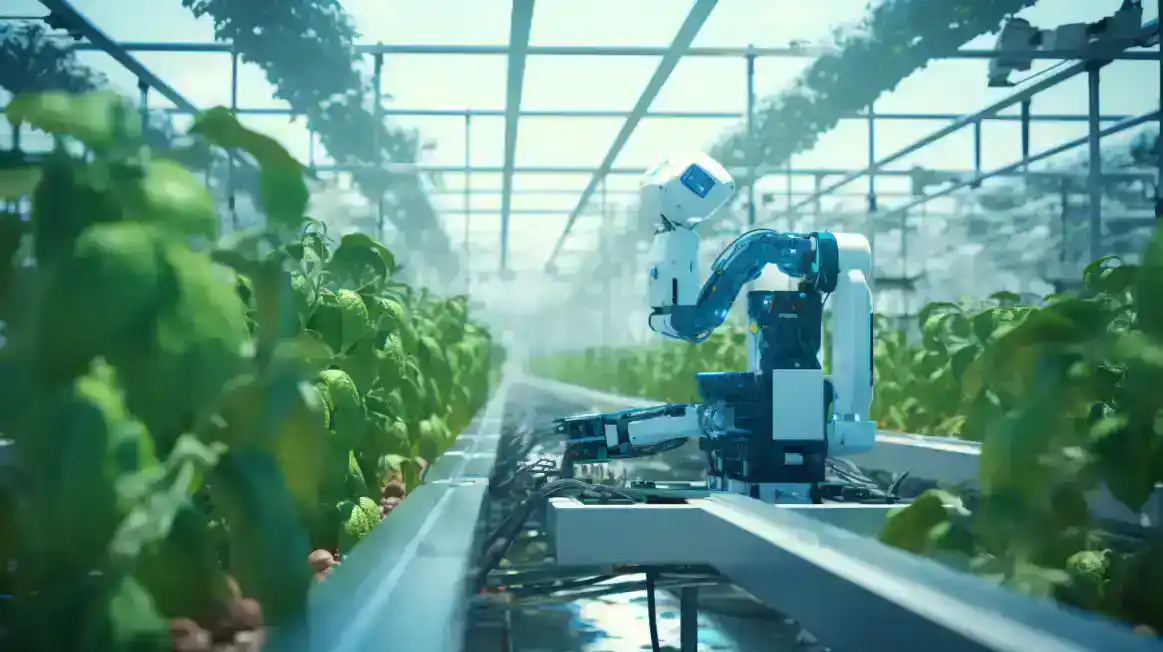Table of Contents
Japan is embracing smart agriculture as a solution to its acute labor shortage and rising demand for food. By entrusting more complex and tedious tasks to artificial intelligence, farmers hope to increase their productivity and efficiency.
AI Robots for Greenhouse Farming
The large-scale greenhouse farming sector, which has begun to deploy AI robots developed by innovative ventures, is one of the trend’s forerunners. These machines can perform various functions, such as harvesting, sorting, and packaging, that would otherwise require human labor. In doing so, they are reshaping the future of farming in Japan.
In Hanyu, a city in eastern Japan’s Saitama Prefecture, a farm called Takamiya No Aisai has been using an AI robot to pick cucumbers since September. The robot, which has four wheels and a camera, can identify ripe cucumbers and cut them off with precision, without damaging the stems. It can collect one to three cucumbers every two minutes and place them in a case.
“We were initially afraid that the robot might cut off the cucumber stems, but it moves accurately,” said Takeshi Yoshida, the head of the farm. “We expect much out of the robot now that labor is in such short supply.”
The farm is operated by a subsidiary of Takamiya Co, which manages agricultural greenhouses and other facilities. The robot was developed by Agrist Inc., a start-up founded in 2019 in Miyazaki Prefecture, southwestern Japan. Agrist has been working on harvesting robots for a variety of crops, including tomatoes, strawberries, and melons. Takamiya No Aisai is the first farm to lease a robot from Agrist, which hopes to expand its business to other farms.
Another start-up that is making waves in the smart agriculture field is Inaho Inc., based in Kamakura, Kanagawa Prefecture, near Tokyo. Inaho has leased an AI robot to a farm in the Netherlands, where it can automatically pick cherry tomatoes in bunches or individually, depending on the mechanism employed.
The robot uses artificial intelligence to analyze images and select multiple tomatoes that are ripe and easy to pick, before using its arm to harvest them. As tomatoes tend to cluster around the leaves and stems, harvesting robots require a sophisticated mechanism, which makes them expensive to develop. As a result, Inaho designed a robot that can harvest roughly 40% of matured tomatoes at night while leaving the rest for human workers during the day.
Inaho aims to export its smart agriculture technology to the world, starting with the Netherlands, which is a global leader in agri-food. “Although more time is needed to let robots harvest all crops, those currently available can sufficiently support farms with labor shortages,” said Soya Oyama, chief operating officer at Inaho. The company has also developed an asparagus harvesting robot and intends to begin leasing the machines in fiscal 2025.
AI Robots for Open-Field Farming

Japan is exploring a new frontier in agriculture, according to Takanori Fukao, professor of robotics at the University of Tokyo. “Starting with greenhouse cultivation where harvesting robots can move easily, examples of its introduction to open-field cultivation are likely to increase,” Fukao said. “In the future, in order to make full use of robots, it’s likely that farms will have to be prepared by taking into account the placement of crops in advance, for instance,” he said.
What are some benefits of smart agriculture?
Smart agriculture can assist farmers in monitoring, analyzing, and optimizing farm operations by collecting and processing data from various sources. Smart agriculture can also enable more sustainable and resilient food systems by addressing the challenges of population growth, climate change, and food security.
Some advantages of smart agriculture include:
- Data collection and processing: Using smart sensors and devices, farmers can automate real-time data collection and processing. This can assist farmers in better controlling and managing processes like irrigation, fertilization, and pest control.
- Increased accuracy and precision: Smart agriculture can improve farming accuracy and precision by utilizing artificial intelligence and analytics to detect and correct errors and provide optimal solutions. AI robots, for example, can recognize and harvest ripe and easy-to-pick fruits and vegetables without damaging the stems or leaves.
- Improved production efficiency: Smart agriculture can improve farming production efficiency by reducing waste of resources such as water, energy, and chemicals. IoT devices, for example, can monitor soil moisture, temperature, humidity, and other parameters and adjust irrigation and fertilization accordingly.
- Reduced production costs: Smart agriculture can reduce farming production costs by reducing the need for manual labor while increasing crop yield and quality. Drones, for example, can fly over fields and capture high-resolution images, as well as use artificial intelligence to detect weeds, diseases, pests, and nutrient deficiencies and apply targeted treatments.
- Better food safety and security: Smart agriculture can improve food safety and security by ensuring product traceability and quality while reducing contamination and spoilage risks. Smart packaging and labeling, for example, can provide information on the origin, freshness, and shelf life of products, as well as alert consumers and retailers to any issues.
Smart agriculture is a promising field that has the potential to transform the farming industry and the food industry’s future.





